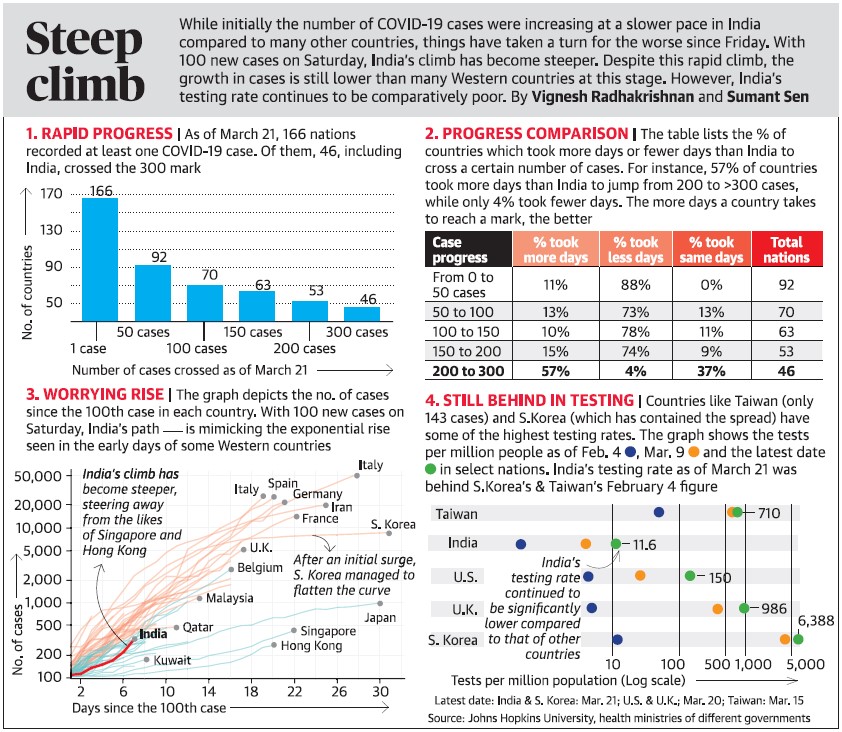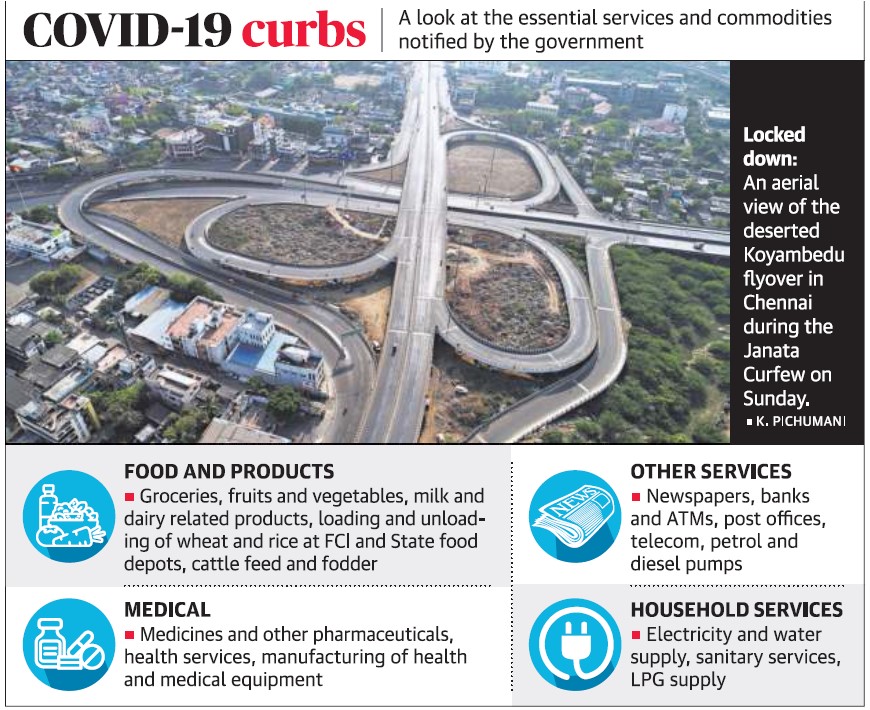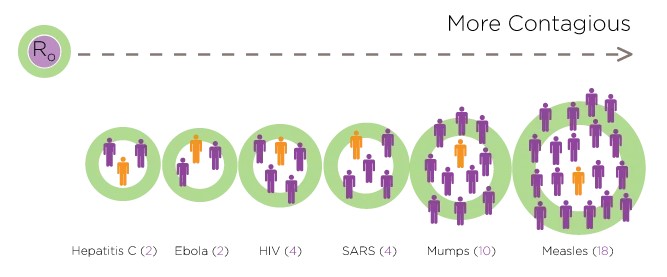Contents:
- 80 districts go into lockdown to contain spread of virus
- COVID-19 is a new animal in the zoo
- Pursue no-trust motion: Madhya Pradesh Governor tells Speaker
- Isolation is India’s best weapon: ICMR
- IIT-D team develops a cheaper COVID-19 test
- Lessons from Italy for the COVID-19-wracked world
80 DISTRICTS GO INTO LOCKDOWN TO CONTAIN SPREAD OF VIRUS
Focus: GS-III Disaster Management
Why in news?
- All train, metro and inter-State transport services across the country were suspended on Sunday till March 31 as the death toll from COVID-19 rose to seven nationwide, and the number of confirmed cases stood at 396.
- Unprecedented restrictions were imposed in 80 districts across 17 States and five Union Territories affected by the pandemic.
Details
- State governments will issue orders allowing only essential services to operate in districts with confirmed COVID-19 cases.
- The focus should be on closure of all activities except essential services such as hospitals, telecom, medicine shops and provision stores.
- The new measures can be described as further “pre-emptive” actions, given the “sharp increase” in the number of confirmed COVID-19 cases in the country after curbs on international travel, contact tracing and efforts at social distancing.
- The ‘Janata Curfew’ on 22nd March could also be a precursor of more stringent measures.

Recommendations
- State governments could request industries / establishments allow their staff to work from home and “provide renumeration to them during this period”.
- States could also take appropriate measures to help poor and vulnerable sections, including casual workers, in order to mitigate any hardships that might be caused.

COVID-19 IS A NEW ANIMAL IN THE ZOO
Focus: GS-III Science and Technology, Disaster Management
Why in news?
- Co-chair of the Empowered Committee for COVID-19 Response, India, Dr. V.K. Paul said the changed circumstances of the spread of the disease called for a revised testing strategy and marshalling all resources to contain the pandemic.
- He also indicated that India is close to rolling out a simpler, indigenous testing kit for the virus.
- COVID-19 is a new animal in the zoo – meaning we are still understanding the virus.
The COVID-19 situation is unpredictable
- We have been containing it to a large extent but the way these things pan out, emerging scenarios are unpredictable and can be very serious, so let us put our act together.
- This has the potential to become an outbreak and become bigger and we cannot rule that out.
- India so far has been in a reasonably good shape and we have not seen any deaths which are unexplained.
- COVID-19 is a new animal in the zoo, we are still understanding the virus that hasn’t seen a full cycle of season, so cannot say conclusively how it will behave.
Lack of health infrastructure
- It is no secret that that India’s health infrastructure needs to be augmented and that we need to double of patients-bed and patient-medical staff ratio.
- We are evolving as country and we have been emphasising the need to increase of healthcare foot print from Tier 2 to Tier 3 cities.
- We should have a much stronger and much bigger and much more competent health system and that journey has many more milestones to be achieved.
How are we handling the Healthcare Infrastructure?
- Currently States across India have been instructed to marshal all their resources to ensure that we are able to contain the virus.
- They have been asked to use all legal and emergency powers and funds to cater to any medical situation that may come about.
- It is a situation for which you have to pull out all stops and get makeshift arrangements if need be.
- So far India has remained relatively safe, but we need to be aware and prepared.
How will the 14-hour ‘Janata Curfew’ help?
- This one-day bandh is the only way we can cut down or dent transmission.
- That’s the good, old way things work, when we don’t have a medicine, we don’t have the vaccine, you have to make sure that it doesn’t pass on to the next person.
- While we cannot create a perfect situation so social distancing is key and this drill is essential.
Where are we in terms of making available testing kits and vaccine?
- We are looking at two types of technologies/products — one is diagnostic kits and the other, of course, is vaccine which is a long term solution.
- We are very close to making available a simpler and indigenous diagnostic test.
- There are 4 to 6 very promising options being carried out and we are very close to an early validation and early scale up.
- Vaccine pipeline will be about eight months to a year or more.
- If vaccine comes out somewhere else, they may find it very sensible to manufacture here in India.
PURSUE NO-TRUST MOTION: MADHYA PRADESH GOVERNOR TELLS SPEAKER
Focus: GS-II Governance, Prelims
Why in news?
The day the BJP leaders had met him, Madhya Pradesh Governor directed Speaker to convene the session so that legislators could act on the no-confidence motion pending against him.
What is a no-confidence motion?
- A government can function only when it has majority support in the Lok Sabha.
- The party can remain in power when it shows its strength through a floor test which is primarily taken to know whether the executive enjoys the confidence of the legislature.
- If any member of the House feels that the government in power does not have a majority then he/she can move a no-confidence motion.
- If the motion is accepted, then the party in power has to prove its majority in the House.
- The member need not give a reason for moving the no-confidence motion.
- According to rule 198 of the Rules of Procedure and Conduct of the Lok Sabha, a no-confidence motion is “a motion expressing want of confidence in the Council of Ministers.”
- This motion can be moved when “the Member asking for leave shall, by 10.00 hours on that day give to the Secretary-General a written notice of the motion which such member proposes to move.”
- The Speaker then, once satisfied that the motion is in order, will ask the House if the motion can be adopted.
How is the No-confidence Motion passed?
- Those Members that support the motion will have to rise in their seats, and with a minimum of 50 Members’ approval, the motion can be moved.
- A no-confidence motion needs a simple majority vote to pass the House (i.e., 50% of members present and voting).
- If individuals or parties abstain from voting, those numbers will be removed from the overall strength of the House and then the majority will be taken into account.
- If the government is not able to prove its majority in the House, then the government of the day has to resign.
ISOLATION IS INDIA’S BEST WEAPON: ICMR
Focus: GS-III Disaster Management, Science and Technology
Why in news?
Isolation, and not indiscriminate testing, is the only way India can limit the spread of COVID-19: Director-General, Indian Council of Medical Research (ICMR) said on 22nd March 2020.
What ICMR Director General had to say?
- A lockdown is the most important step in breaking transmission of the infection.
- The State governments have now been directed to earmark hospitals specifically to accommodate COVID-19 patients.
- ICMR noted that it had tested over 16,109 individuals, and over 7,000 were currently under surveillance.
- We have enough stock of personal protection equipment and have asked the States to use all their resources to ensure that the poor and disadvantaged groups don’t suffer.
- Our approach is preventive while being prepared.
IIT-D TEAM DEVELOPS A CHEAPER COVID-19 TEST
Focus: GS-III Science and Technology
Why in news?
- Researchers at the Indian Institute of Technology here have developed a method to detect COVID-19 which can significantly reduce the test cost, making it affordable for large sections.
- The “probe-free detection assay” has been optimised and tested for sensitivity at the research laboratories of IIT.
Other Details
- Considering the scale of the ongoing pandemic, development of indigenous kits is the need of the hour.
- The central government on 21st March 2020, recommended that the maximum charge for a COVID-19 test by private laboratories should not exceed ₹4,500.
- All private laboratories which have NABL (National Accreditation Board for Testing and Calibration Laboratories) accreditation for real-time PCR (polymerase chain reaction) assay for RNA virus will be allowed to conduct COVID-19 tests, according to the guidelines issued by the Indian Council of Medical Research (ICMR) for COVID-19 testing in private laboratories, which were notified by the Health Ministry on 21st March 2020 night.
LESSONS FROM ITALY FOR THE COVID-19-WRACKED WORLD
Focus: GS-III Disaster Management
Why in news?
On March 20, Italy reported 5,900-odd fresh cases and 627 deaths, the highest daily tally of mortality reported from anywhere in the world.
‘Age’ Factor in Europe?
- Europe, after the tumult of two World Wars, had embarked on the road to recovery through mutual cooperation, exemplified by the Maastricht Treaty in 1993, which established it as a union of constituent nations, a borderless region to facilitate trade and the free movement of people.
- The union, reinforced by the post-War emphasis on welfare, led to the western side of the continent establishing some of the most advanced health care systems, which resulted in the high life expectancy rates seen now.
- Indeed, death rates exceeded birth rates, putting the population in a state of decline where the net replacement rate was less than one.
- Thus, Europe aged, even as it became relatively wealthy.
Why Italy?
- Italy’s famed Colosseum and other attractions drew millions of tourists each year, making the country the fifth most popular tourist destination.
- An open border meant that the incoming tourist could travel anywhere in Europe.
- Perhaps these factors, that is, an ageing population, a high rate of internal migration, and a constant flow of tourists proved to be its undoing when the pandemic came knocking at its door.
- Importantly, contact tracing from Patient #1 did not work in Italy. The country, along with Spain (the second most affected country in Europe) is popular with retirement planners. Its beaches and villas have attracted several post-retirement settlements.
- Thus, a rapidly multiplying cluster of infections, which affected a predominantly older population, put a severe strain on one of the most developed health care systems in the world.
- Perhaps the most significant aspect of this epidemic in Italy was the response from the people. They were not used to restrictions. They could not follow the stringent discipline enforced in China. Nearly 44,000 people have been booked across the country for defying prohibition orders.
R0 (Pronounced: R – Naught)
- It’s a mathematical term that indicates how contagious an infectious disease is. It’s also referred to as the reproduction number.
- In epidemiology, the R0 of an infection can be thought of as the expected number of cases directly generated by one case in a population where all individuals are susceptible to infection.

- The R0 for Covid-19 has been estimated to range from 1.5 to 3.5 and to effectively stop the pandemic, we need to reduce this to less than 1.
- This is what is meant by “flattening the curve”, a term that has gone viral in social media, which possibly explains why the benefits of quarantine and social distancing have gained social acceptance so quickly.
Significance of R0
Three possibilities exist for the potential spread or decline of a disease, depending on its R0 value:
- If R0 is less than 1, each existing infection causes less than one new infection. In this case, the disease will decline and eventually die out.
- If R0 equals 1, each existing infection causes one new infection. The disease will stay alive and stable, but there won’t be an outbreak or an epidemic.
- If R0 is more than 1, each existing infection causes more than one new infection. The disease will spread between people, and there may be an outbreak or epidemic.
Importantly, a disease’s R0 value only applies when everyone in a population is completely vulnerable to the disease. This means:
- no one has been vaccinated
- no one has had the disease before
- there’s no way to control the spread of the disease
What make Coronavirus more deadly?
- What makes Covid-19 different from flu is the fact that humans lack antibodies to fight it, which is why it is termed “novel”.
- By implication, this means the lack of effective treatment and hence a higher mortality rate.
- As the case count increased from a few hundred to several thousands, China’s apparently draconian lockdown worked to ebb the spread of the disease.
- The measures, which appear to have struck a wrong chord with Europeans, have had fatal consequences.
Issue of Asymptomatic cases
- Eighty per cent of COVID-19 patients were asymptomatic, thereby reducing the total positive tests in comparison to the prevalence of the disease.
- However, 40 per cent of those diagnosed positive also required hospitalisation, 12 per cent required intensive care, a few among them the most critical equipment.
- Perhaps no other disease that we know in modern medicine has required such a high level of ventilator utilisation.
- What started as a small number escalated rapidly to several thousands.
Other Factors of the Outbreak
- A significant feature of the outbreak in its early days was the high infection rate among health care personnel, which had a significant impact on the system’s ability to treat the surge of cases.
- The high rate of mortality has also been attributed to the drug Ibuprofen, an over-the-counter pain reliever as well as an antipyretic whose availability has been duly curtailed since then. Ibuprofen lowered the subjects’ immune response, which hampered their recovery.
What can India Learn from Italy?
- With a predominantly young population, India may appear deceptively to be at an advantage.
- However, India cannot afford to be complacent.
- Vigilant screening and isolation of suspected cases needs to be done.
- The country is still in stage II (local transmission), during which training to health care professionals, vigorous contact tracing and improved testing capacity should be the immediate priority.
- Ramping up ICU beds and arranging for ventilators for urgent use requires to be a key priority.
- The best way India can manage this epidemic is by stopping its spread in a densely populated country with high levels of air pollution and a high prevalence of respiratory diseases.





